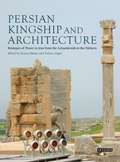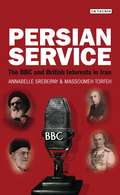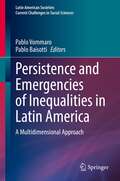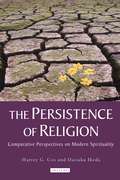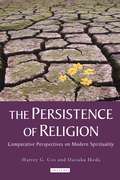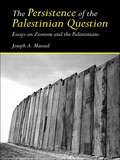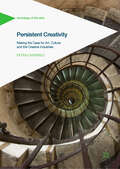- Table View
- List View
The Persian Gulf in History
by L. PotterExploring the history of the Persian Gulf from ancient times until the present day, leading authorities treat the internal history of the region and describe the role outsiders have played there. The book focuses on the unity and identity of Gulf society and how the Gulf historically has been part of a cosmopolitan Indian Ocean world.
Persian Interventions: The Achaemenid Empire, Athens, and Sparta, 450-386 BCE
by John O. HylandThirty years after Xerxes invaded Greece, the Achaemenid Persian Empire ended its long war with Athens. For the next four decades, the Persians tolerated Athenian control of their former tributaries, the Ionian Greek cities of western Anatolia. But during the Peloponnesian War, Persia reclaimed Ionia and funded a Spartan fleet to overthrow Athenian power. It took eight long years for Persia to triumph, and Sparta then turned on its benefactors, prompting Persia to transfer aid to Athens in the Corinthian War. The peace of 386 reiterated imperial control of Ionia and compelled both Sparta and Athens to endorse a Persian promise of autonomy for Greeks outside Asia. In Persian Interventions, John O. Hyland challenges earlier studies that assume Persia played Athens against Sparta in a defensive balancing act. He argues instead for a new interpretation of Persian imperialism, one involving long-term efforts to extend diplomatic and economic patronage over Greek clients beyond the northwestern frontier. Achaemenid kings, he asserts, were less interested in Ionia for its own sake than in the accumulation of influence over Athens, Sparta, or both, which allowed them to advertise Persia;€™s claim to universal power while limiting the necessity of direct military commitment. The slow pace of intervention resulted from logistical constraints and occasional diplomatic blunders, rather than long-term plans to balance and undermine dangerous allies. Persian Interventions examines this critical period in unprecedented depth, providing valuable new insights for the study of Achaemenid Persia and classical Greece. Its conclusions will interest not only specialists in both fields but also students of ancient and modern comparative historical imperialism.
Persian Interventions: The Achaemenid Empire, Athens, and Sparta, 450-386 BCE
by John O. HylandThirty years after Xerxes invaded Greece, the Achaemenid Persian Empire ended its long war with Athens. For the next four decades, the Persians tolerated Athenian control of their former tributaries, the Ionian Greek cities of western Anatolia. But during the Peloponnesian War, Persia reclaimed Ionia and funded a Spartan fleet to overthrow Athenian power. It took eight long years for Persia to triumph, and Sparta then turned on its benefactors, prompting Persia to transfer aid to Athens in the Corinthian War. The peace of 386 reiterated imperial control of Ionia and compelled both Sparta and Athens to endorse a Persian promise of autonomy for Greeks outside Asia. In Persian Interventions, John O. Hyland challenges earlier studies that assume Persia played Athens against Sparta in a defensive balancing act. He argues instead for a new interpretation of Persian imperialism, one involving long-term efforts to extend diplomatic and economic patronage over Greek clients beyond the northwestern frontier. Achaemenid kings, he asserts, were less interested in Ionia for its own sake than in the accumulation of influence over Athens, Sparta, or both, which allowed them to advertise Persia;€™s claim to universal power while limiting the necessity of direct military commitment. The slow pace of intervention resulted from logistical constraints and occasional diplomatic blunders, rather than long-term plans to balance and undermine dangerous allies. Persian Interventions examines this critical period in unprecedented depth, providing valuable new insights for the study of Achaemenid Persia and classical Greece. Its conclusions will interest not only specialists in both fields but also students of ancient and modern comparative historical imperialism.
Persian Kingship and Architecture: Strategies of Power in Iran from the Achaemenids to the Pahlavis (International Library of Iranian Studies)
by Talinn Grigor Sussan BabaieSince the Shah went into exile and the Islamic Republic was established in 1979 in the wake of the Iranian Revolution, the very idea of monarchy in Iran has been contentious. Yet, as Persian Kingship and Architecture argues, the institution of kingship has historically played a pivotal role in articulating the abstract notion of 'Iran' since antiquity. These ideas surrounding kingship and nation have, in turn, served as a unifying cultural force despite shifting political and religious allegiances. Through analyses of palaces, mausolea, art, architectural decoration and urban design the authors show how architecture was appropriated by different rulers as an integral part of their strategies of legitimising power. They refer to a variety of examples, from the monuments of Persepolis under the Achaemenids, the Sassanian palaces at Kish, the Safavid public square of Isfahan, the Qajar palaces at Shiraz and to the modernisation and urban agendas of the Pahlavis. Drawing on archaeology, ancient, medieval, early modern and modern architectural history, both Islamic and secular, this book is indispensable for all those interested in Iranian studies and visual culture.
Persian Paradises at Peril: Landscape Planning and Management in Contemporary Iran (The Urban Book Series)
by Farzin Fardanesh Fatemeh Farnaz ArefianThis book offers a resourceful collection of essays examining recent efforts to respond to the challenges of planning, management and conserving landscapes in contemporary Iran, the home of Persian gardens. Drawing on selected recent studies, the chapters discuss the following topics: The sphere of knowledge and theoretical bases, including a survey of recent and ongoing research;Persian gardens remaining from the 6th century BC to the 19th century AD, which have influenced garden design in a vast geographic domain extending from India to Spain;Management and conservation of cultural landscapes, historic urban landscapes (HUL), road landscapes, and natural landscapes in the face of changes in climatic conditions and livelihood practices affecting their delicate dynamic balance and functions essential to their distinctive character; and Historic Territorial Landscapes (HTL) formed and evolved along the Silk and Spice Roads as compositions of tangible and intangible elements resulting from movement, exchanges and dialogue in space and over time.The book is a useful resource for a range of academics and professionals, such as landscape architects and managers, landscape historians and conservationists, and urban planners and managers.
Persian Petroleum: Oil, Empire and Revolution in Late Qajar Iran
by Leonardo DavoudiUsing newly-uncovered private papers, as well as public and private archives in three countries, this book tells the definitive history of the first discovery of oil in Iran - the first discovery of oil in the Middle East. Exploring the formal and informal dealings of politicians, investors, civil servants and intermediaries Leonardo Davoudi charts the development of Persian petroleum from uncertain beginnings to becoming one of Britain's largest oil companies with the British government as its principal shareholder. Assessing the relationship between economic and political forces within the British empire and the relationship of foreign economic forces and domestic political forces in Persia, the book also explores the role of intermediation, informal empire, the Anglo-Russian rivalry over Persia, British naval developments and Persian political developments.
Persian Petroleum: Oil, Empire and Revolution in Late Qajar Iran
by Leonardo DavoudiUsing newly-uncovered private papers, as well as public and private archives in three countries, this book tells the definitive history of the first discovery of oil in Iran - the first discovery of oil in the Middle East. Exploring the formal and informal dealings of politicians, investors, civil servants and intermediaries Leonardo Davoudi charts the development of Persian petroleum from uncertain beginnings to becoming one of Britain's largest oil companies with the British government as its principal shareholder. Assessing the relationship between economic and political forces within the British empire and the relationship of foreign economic forces and domestic political forces in Persia, the book also explores the role of intermediation, informal empire, the Anglo-Russian rivalry over Persia, British naval developments and Persian political developments.
The Persian Prince: The Rise and Resurrection of an Imperial Archetype
by Hamid DabashiWith its title borrowed from Machiavelli, The Persian Prince goes far beyond Machiavelli's wildest imagination as to how to rule the world. Hamid Dabashi articulates a bold new idea of the Persian Prince—a metaphor of political authority, a figurative ideal deeply rooted in the collective memories of multiple nations, and a literary construct that connected Muslim empires across time and space and continues to inform political debate today. Drawing on works from Classical Antiquity and the vast Persianate worlds from India to the Mediterranean, as well as the Hebrew Bible and European medieval mirrors for princes, Dabashi engages a diverse body of political thought to reveal the construction of the Persian Prince as a potent archetype. He traces this archetype through its varied historic gestations and finds it resurfacing in postcolonial political thought as a rebel, a prophet, a poet, and a nomad. Bringing poetics and politics together, Dabashi shows how this archetypal figure has long defined political authority throughout the wider Iranian and Islamic worlds. With meticulous attention to literary and poetic texts, moral and philosophical treatises, allegorical and anecdotal stories, sacred and secular evidence, visual and performing arts, histories of global empires and colonial conquests, this sweeping work offers a deeply learned, richly erudite, and transformative piece of critical thinking. As Dabashi shows, the Persian Prince remains the stuff of current debate across the Muslim and Persianate worlds, in contestations over the public domain and the collective will to power, and above all in the prospects of democratic institutions.
The Persian Prince: The Rise and Resurrection of an Imperial Archetype
by Hamid DabashiWith its title borrowed from Machiavelli, The Persian Prince goes far beyond Machiavelli's wildest imagination as to how to rule the world. Hamid Dabashi articulates a bold new idea of the Persian Prince—a metaphor of political authority, a figurative ideal deeply rooted in the collective memories of multiple nations, and a literary construct that connected Muslim empires across time and space and continues to inform political debate today. Drawing on works from Classical Antiquity and the vast Persianate worlds from India to the Mediterranean, as well as the Hebrew Bible and European medieval mirrors for princes, Dabashi engages a diverse body of political thought to reveal the construction of the Persian Prince as a potent archetype. He traces this archetype through its varied historic gestations and finds it resurfacing in postcolonial political thought as a rebel, a prophet, a poet, and a nomad. Bringing poetics and politics together, Dabashi shows how this archetypal figure has long defined political authority throughout the wider Iranian and Islamic worlds. With meticulous attention to literary and poetic texts, moral and philosophical treatises, allegorical and anecdotal stories, sacred and secular evidence, visual and performing arts, histories of global empires and colonial conquests, this sweeping work offers a deeply learned, richly erudite, and transformative piece of critical thinking. As Dabashi shows, the Persian Prince remains the stuff of current debate across the Muslim and Persianate worlds, in contestations over the public domain and the collective will to power, and above all in the prospects of democratic institutions.
Persian Service: The BBC and British Interests in Iran
by Annabelle Sreberny Massoumeh TorfehRumour and speculation in Iran have been rife for generations that the BBC has had a hand in every political upheaval in the country. In this vein the BBC has become a notable element in the complex and tortured narrative of Anglo-Iranian relations. The BBC Persian Service was initially developed in 1940 to prepare and broadcast British war-time propaganda. And it has since been seen by many in Iran as an integral part of British policy-making in the region. Thirty years ago, the Shah of Iran regarded the BBC Persian Service radio as his 'enemy number one' and held it responsible for promoting the revolution of 1979. Only a couple decades earlier, the BBC Persian Service was widely accused for having been complicit in the CIA-led 1953 coup against Prime Minister Mohammad Musaddiq. And a decade earlier, the BBC Persian Service was strongly linked to the British-planned removal of Reza Shah in 1941. The BBC Persian service has frequently been perceived as an entity which was not simply a vehicle to record the changes occurring in Iran and throughout the Middle East, but rather an active agent of change.In this book, Annabelle Sreberny and Massoumeh Torfeh track the history of the BBC Persian Service, critically analysing both the assumptions that the BBC is a standard bearer for objective reporting and representations of it as a simple tool of Western interests. Also examining the history of relations between the Foreign Office and the BBC Persian Service, they demonstrate that these have never been pre-defined or rigid. Instead, they explore how both institutions have moved from an interest in what can crudely be called state-orchestrated 'propaganda' to a more subtle advocacy of fair and balanced journalism as the best agent of British values and influence.
Persistence and Emergencies of Inequalities in Latin America: A Multidimensional Approach (Latin American Societies)
by Pablo Baisotti Pablo VommaroThis book adopts a multidimensional approach to analyze both the historical and emerging factors that contribute to make Latin America and the Caribbean the most unequal region in the world. Social inequality is a historical characteristic of the region, but at the beginning of the 21st century, a handful of progressive governments seemed to be adopting policies that could reduce this historical trend. Many of these efforts, however, were blocked or reversed by the COVID-19 pandemic, which both exposed the persistence of historical trends and contributed to the emergency of new forms of inequality in the region.The different chapters in this contributed volume adopt a multidimensional, intersectional, perspective to analyze both the persistence and the emergency of social devices of production and reproduction of inequalities in the diverse Latin American and Caribbean temporal spatialities. The issues analyzed in the different chapters revolve around four main axes: a) persistence of generational and intergenerational inequalities; b) structural gender inequality; c) intertwined social inequalities: race, class and social structure and; c) historical and economic dimension of inequality. Persistence and Emergencies of Inequalities in Latin America: A Multidimensional Approach will be of interest to researchers interested in the study of social inequality and social justice in different fields of the human and social sciences, such as sociology, political science, history, economics, anthropology and education. It will also be a valuable tool for policy makers and social activists engaged in the discussion, advocacy and implementation of public policies aimed at reducing social inequalities.
The Persistence of Critical Theory (Culture and Civilization)
by Gabriel R. RicciThe latest volume of Culture and Civilization gathers contemporary exponents of critical theory, specifically those based in the Frankfurt School of social thinking. Collectively, this volume demonstrates the continuing intellectual viability of critical theory, which challenges the limits of positivism and materialism. We may question how the theoretical framework of Marxism fails to coordinate with the conditions that defined labor forces, as did Max Horkheimer and Theodor Adorno, or deliberate on the conditions that justify the claims we make through public discourse, as did Jurgen Habermas. Or, like Axel Honneth, we may reflect on recognition theory as a means of addressing social problems. Whatever our objective, the focus of critical theory continues to be the consciousness of established "positive" interests that, without debate, may sustain injustices or conditions which the public may not have chosen to impose. Throughout the hardship of punitive dismissal and exile in the 1930s and 40s, and the shock of the New Left in the 1960s and 70s, and finally the later linguistic and pragmatic turn, the Frankfurt School has sustained the idea that people escape disaffection and alienation when their knowledge of the social and political world is dialectically mediated through creative interaction. This new volume in the Culture and Civilization series continues the tradition of critical thought.
The Persistence of Critical Theory: Culture And Civilization (Culture and Civilization)
by Gabriel R. RicciThe latest volume of Culture and Civilization gathers contemporary exponents of critical theory, specifically those based in the Frankfurt School of social thinking. Collectively, this volume demonstrates the continuing intellectual viability of critical theory, which challenges the limits of positivism and materialism. We may question how the theoretical framework of Marxism fails to coordinate with the conditions that defined labor forces, as did Max Horkheimer and Theodor Adorno, or deliberate on the conditions that justify the claims we make through public discourse, as did Jurgen Habermas. Or, like Axel Honneth, we may reflect on recognition theory as a means of addressing social problems. Whatever our objective, the focus of critical theory continues to be the consciousness of established "positive" interests that, without debate, may sustain injustices or conditions which the public may not have chosen to impose. Throughout the hardship of punitive dismissal and exile in the 1930s and 40s, and the shock of the New Left in the 1960s and 70s, and finally the later linguistic and pragmatic turn, the Frankfurt School has sustained the idea that people escape disaffection and alienation when their knowledge of the social and political world is dialectically mediated through creative interaction. This new volume in the Culture and Civilization series continues the tradition of critical thought.
The Persistence of Global Masculinism: Discourse, Gender and Neo-Colonial Re-Articulations of Violence
by Lucy Nicholas Christine AgiusThis book examines whether we are witnessing the resilience, persistence and adaptation of masculinist discourses and practices at both domestic and international levels in the contemporary global context. Beginning with an innovative conceptualisation of masculinism, the book draws on interdisciplinary work to analyse its contours and practices across four case studies. From the anti-feminist backlash that can be found in various men’s rights movements, and responses to gender-based and sexual violence, to the masculinist underpinnings of human rights discourse, and modes of intervention to protect, including drone warfare. This interdisciplinary work will appeal to students and scholars of gender studies, security and international relations, and sociology.
The Persistence of Global Masculinism: Discourse, Gender and Neo-Colonial Re-Articulations of Violence
by Lucy Nicholas Christine AgiusThis book examines whether we are witnessing the resilience, persistence and adaptation of masculinist discourses and practices at both domestic and international levels in the contemporary global context. Beginning with an innovative conceptualisation of masculinism, the book draws on interdisciplinary work to analyse its contours and practices across four case studies. From the anti-feminist backlash that can be found in various men’s rights movements, and responses to gender-based and sexual violence, to the masculinist underpinnings of human rights discourse, and modes of intervention to protect, including drone warfare. This interdisciplinary work will appeal to students and scholars of gender studies, security and international relations, and sociology.
The Persistence of Religion: Comparative Perspectives on Modern Spirituality
by Harvey G. Cox Daisaku IkedaIn the nineteenth century, Nietzsche famously announced that God was dead. In the twentieth century, increasing reliance on science and technology led to a widespread rejection of belief on the grounds of its irrationality. Yet religion has not died. In fact, the opposite has occurred: it has persisted and proliferated. Despite the relentless pursuit of scientific advancement, in the twenty-first century we now see religious influence everywhere. In this wide-ranging dialogue, two leading commentators on religion address - from their different but complementary traditions of Christianity and Buddhism - the continuing appeal of spirituality to people eager to explore fundamental questions of meaning. The authors indicate that science, for all its benefits, has limits of explanation. It may be able to show how, but not necessarily why. Yet belief too must not go unchallenged, since, as Ikeda says, 'religion can become either a medicine or a poison'. What then is the proper role of religion in a world plagued by intolerance and extremism? The authors point to its place in dialogue, education and peacebuilding.They emphasise the centrality of non-violence, and the inspiring examples of Gandhi, Martin Luther King and Nelson Mandela. In so doing they recount formative experiences of involvement in the civil rights movement and protest against Vietnam (Cox) and personal exposure to the misery and destruction of war (Ikeda). Their joint vision of a just and true religious sensibility makes a vital contribution to the fields of religion, peace studies and ethics.
The Persistence of Religion: Comparative Perspectives on Modern Spirituality
by Harvey G. Cox Daisaku IkedaIn the nineteenth century, Nietzsche famously announced that God was dead. In the twentieth century, an increasing reliance on science and technology led to a widespread rejection of belief on the grounds of its irrationality. Yet for all the scepticism directed towards it, religion has not died. In fact, the opposite has occurred: it has persisted and proliferated. Despite the relentless pursuit of scientific advancement, in the twenty-first century religious influence may be seen everywhere. In this thoughtful and wide-ranging dialogue, two leading commentators on religion address - from their different but complementary traditions of Christianity and Buddhism - the continuing appeal of spirituality to people eager to explore fundamental questions of meaning and identity. The authors indicate that science, for all the benefits it has conferred, has limits of explanation. It may be able to show how, but not necessarily why. Yet belief too must not go unchallenged, since, as Ikeda says at one point in the dialogue, 'religion can become either a medicine or a poison.'What then is the proper role of religion in a world troubled by intolerance and extremism? The authors point to the significant place that it has in dialogue, education and peacebuilding. They emphasise the centrality of non-violence, and the inspiring examples of Gandhi, Martin Luther King and Nelson Mandela. In so doing they recount their own formative experiences of involvement in the civil rights movement and protest against Vietnam (Cox) and personal exposure to the misery and destruction of war (Ikeda). Their joint vision of a just and true religious sensibility makes a vital contribution to the fields of religion, peace studies and ethics.
The Persistence of the Palestinian Question: Essays on Zionism and the Palestinians
by Joseph MassadIn this erudite and groundbreaking series of essays, renowned author Joseph Massad asks and answers key questions, such as: What has been the main achievement of the Zionist movement? What accounts for the failure of the Palestinian National Movement to win its struggle against Israel? What do anti-Semitism, colonialism and racism have to do with the Palestinian/Israeli 'conflict'? Joseph Massad offers a radical departure from mainstream analysis in order to expose the causes for the persistence of the 'Palestinian Question'. He proposes that it is not in de-linking the Palestinian Question from the Jewish Question that a resolution can be found, but by linking them as one and the same question. All other proposed solutions, the author argues, are bound to fail. Deeply researched and documented, this book analyzes the failure of the 'peace process' and proposes that a solution to the Palestinian Question will not be found unless settler-colonialism, racism, and anti-Semitism are abandoned as the ideological framework for a resolution. Individual essays further explore the struggle over Jewish identity in Israel and the struggle among Palestinians over what constitutes the Palestinian Question today.
The Persistence of the Palestinian Question: Essays on Zionism and the Palestinians
by Joseph MassadIn this erudite and groundbreaking series of essays, renowned author Joseph Massad asks and answers key questions, such as: What has been the main achievement of the Zionist movement? What accounts for the failure of the Palestinian National Movement to win its struggle against Israel? What do anti-Semitism, colonialism and racism have to do with the Palestinian/Israeli 'conflict'? Joseph Massad offers a radical departure from mainstream analysis in order to expose the causes for the persistence of the 'Palestinian Question'. He proposes that it is not in de-linking the Palestinian Question from the Jewish Question that a resolution can be found, but by linking them as one and the same question. All other proposed solutions, the author argues, are bound to fail. Deeply researched and documented, this book analyzes the failure of the 'peace process' and proposes that a solution to the Palestinian Question will not be found unless settler-colonialism, racism, and anti-Semitism are abandoned as the ideological framework for a resolution. Individual essays further explore the struggle over Jewish identity in Israel and the struggle among Palestinians over what constitutes the Palestinian Question today.
Persistence Pays: U.S. Agricultural Productivity Growth and the Benefits from Public R&D Spending (Natural Resource Management and Policy #34)
by Julian M. Alston Matthew A. Andersen Jennifer S. James Philip G. Pardeygricultural science policy in the United States has profoundly affected the growth and development of agriculture worldwide, not just in the A United States. Over the past 150 years, and especially over the second th half of the 20 Century, public investments in agricultural R&D in the United States grew faster than the value of agricultural production. Public spending on agricultural science grew similarly in other more-developed countries, and c- lectively these efforts, along with private spending, spurred agricultural prod- tivity growth in rich and poor nations alike. The value of this investment is seldom fully appreciated. The resulting p- ductivity improvements have released labor and other resources for alternative uses—in 1900, 29. 2 million Americans (39 percent of the population) were - rectly engaged in farming compared with just 2. 9 million (1. 1 percent) today— while making food and fiber more abundant and cheaper. The benefits are not confined to Americans. U. S. agricultural science has contributed with others to growth in agricultural productivity in many other countries as well as the Un- ed States. The world’s population more than doubled from around 3 billion in 1961 to 6. 54 billion in 2006 (U. S. Census Bureau 2009). Over the same period, production of important grain crops (including maize, wheat and rice) almost trebled, such that global per capita grain production was 18 percent higher in 2006.
The Persistent Activist: How Peace Commitment Develops And Survives
by James Downton Paul WehrThis book explores the movement experience of thirty Colorado peace activists, whose names are changed to conceal their identities. It provides a brief summary of the main currents of collective action theory, noting some of the existing research about participation in social movements.
The Persistent Activist: How Peace Commitment Develops And Survives
by James Downton Paul WehrThis book explores the movement experience of thirty Colorado peace activists, whose names are changed to conceal their identities. It provides a brief summary of the main currents of collective action theory, noting some of the existing research about participation in social movements.
Persistent and Emerging Challenges to Development: Insights for Policy-Making in India (India Studies in Business and Economics)
by Gagari Chakrabarti Supravat Bagli Prithviraj GuhaThis book covers a wide range of the issues in development studies. Recognizing the existence of manifold challenges in achieving and sustaining economic development, it is divided into four sections—(i) The Macroeconomy: Foreign Trade, Structural Transition and the Environment, (ii) Health and Standard of Living, (iii) Education, Human Capital and Evolution of the Employment Quality in India, and (iv) Banking and Credit: Access, Efficiency and Stability. The book brings together a right mix of senior and young economists who use cutting edge econometric techniques and/ or revisit a perennial question with much sharper focus and tools to unravel insights that are important and will inform tomorrow’s theorisation and policy making. The volume looks at important questions like spatial concentration of low infant and child health outcomes, trade liberalisation and export quality, intergenerational occupational mobility, multidimensional poverty incidence in rural India, robustness of the banking sector, to name a few. To do so, the contributions use novel and esoteric methods like machine learning, spatial econometrics, system GMM, quintile regression and counterfactual decomposition (QRCD), and so on. The rich collection holds importance for researchers and policy makers alike, and also for practitioners working in different developmental sectors..
Persistent Creativity: Making the Case for Art, Culture and the Creative Industries (Sociology of the Arts)
by Peter CampbellRecent years have seen the increasing valuation and promotion of ‘creativity’. Future success, we are often assured, will rest on the creativity of our endeavours, often aligned specifically with ‘cultural’ activity. This book considers the emergence and persistence of this pattern, particularly with regards to cultural policy, and examines the methods and evidence deployed to make the case for art, culture and the creative industries. The origins of current practices are considered, as is the gradual accretion of a broad range of meanings around the term ‘creative’, and the implications this has for the success of the wider ‘Creativity Agenda’. The specific experience of the city of Liverpool in adopting and furthering this agenda both in the UK and beyond is considered, as is the persistence of a range of problematic, and often contradictory, assumptions and practices relating to this agenda up to the present day.
Persistent Inequality: Contemporary Realities in the Education of Undocumented Latina/o Students
by Maria Pabon Lopez Gerardo R. LopezThe children of undocumented migrants in the U.S. are trapped at the intersection of two systems in crisis: the public education system and the immigration law system. Based on a long tradition of scholarship in Latino education and on newer critical race theory ideas, Persistent Inequality answers burning questions about how educational policy has to rise to meet the unique challenges of undocumented students’ lives as well as those which face nearly all Latinos in the U.S. educational system. How solid is the Supreme Court precedent, Plyler v. Doe, that allows undocumented children the opportunity to attend public school K-12 free of charge? What would happen if the Supreme Court overruled it? What is the DREAM Act and how would this proposed federal law affect the lives of undocumented students? How have immigration raids affected public school children and school administrators? To shed some light on these vital questions, the authors provide a critical analysis of the various legal and policy aspects of the U.S. educational system, asserting that both the legal and educational systems in this country need to address the living and working conditions of undocumented Latino students and remove the obstacles to educational achievement which these students struggle with daily.


